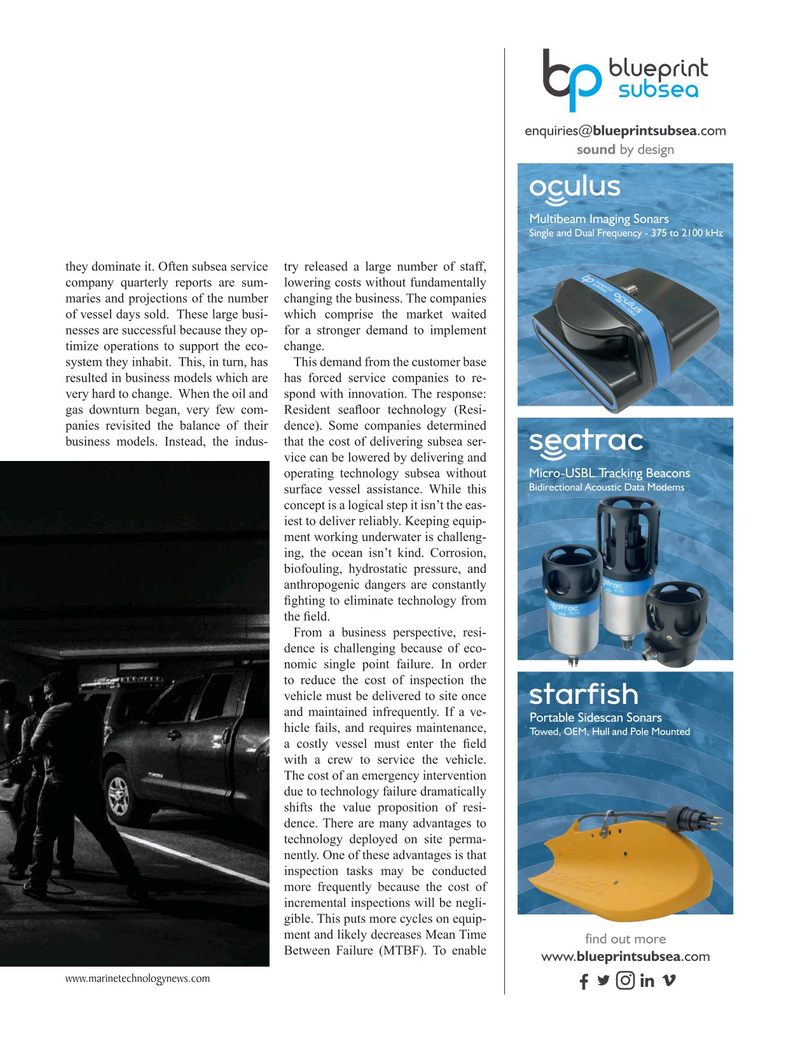
Page 25: of Marine Technology Magazine (April 2019)
Ocean Energy: Oil, Wind & Tidal
Read this page in Pdf, Flash or Html5 edition of April 2019 Marine Technology Magazine
HQTXLULHV#EOXHSULQWVXEVHDFRP
VRXQGE\GHVLJQ 0XOWLEHDP,PDJLQJ6RQDUV 6LQJOHDQG'XDO)UHTXHQF\WRN+] they dominate it. Often subsea service try released a large number of staff, company quarterly reports are sum- lowering costs without fundamentally maries and projections of the number changing the business. The companies of vessel days sold. These large busi- which comprise the market waited nesses are successful because they op- for a stronger demand to implement timize operations to support the eco- change.
system they inhabit. This, in turn, has This demand from the customer base resulted in business models which are has forced service companies to re- very hard to change. When the oil and spond with innovation. The response: gas downturn began, very few com- Resident sea? oor technology (Resi- panies revisited the balance of their dence). Some companies determined business models. Instead, the indus- that the cost of delivering subsea ser- vice can be lowered by delivering and operating technology subsea without 0LFUR86%/7UDFNLQJ%HDFRQV %LGLUHFWLRQDO$FRXVWLF'DWD0RGHPV surface vessel assistance. While this concept is a logical step it isn’t the eas- iest to deliver reliably. Keeping equip- ment working underwater is challeng- ing, the ocean isn’t kind. Corrosion, biofouling, hydrostatic pressure, and anthropogenic dangers are constantly ? ghting to eliminate technology from the ? eld.
From a business perspective, resi- dence is challenging because of eco- nomic single point failure. In order to reduce the cost of inspection the vehicle must be delivered to site once and maintained infrequently. If a ve- 3RUWDEOH6LGHVFDQ6RQDUV hicle fails, and requires maintenance, 7RZHG2(0+XOODQG3ROH0RXQWHG a costly vessel must enter the ? eld with a crew to service the vehicle.
The cost of an emergency intervention due to technology failure dramatically shifts the value proposition of resi- dence. There are many advantages to technology deployed on site perma- nently. One of these advantages is that inspection tasks may be conducted more frequently because the cost of incremental inspections will be negli- gible. This puts more cycles on equip- ment and likely decreases Mean Time
ILQGRXWPRUH
Between Failure (MTBF). To enable
ZZZEOXHSULQWVXEVHDFRP www.marinetechnologynews.com
MTR #3 (18-33).indd 25 4/10/2019 4:12:44 PM

 24
24

 26
26
